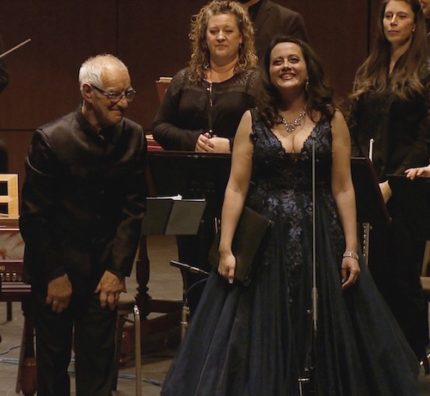Forsythe brings “Classical Heroines” to vibrant life with Kraemer, MOB

Nicholas Kraemer led Music of the Baroque in a program of Handel, Purcell, and Haydn titled “Classical Heroines” Monday night at the Harris Theater, with soprano Amanda Forsythe bringing those heroines to life.
With this title, one might have expected music by Haydn and Mozart or their lesser-known contemporaries, but only one of the vocal selections was from the Classical era (though Dido is a heroine from Classical literature). Semantics apart, the concert was a healthy combination of rarities and old favorites that provided a worthy platform for this celebrated early music specialist.
MOB presented two instrumental offerings by Handel, showcasing the composer at both ends of his career with the Overture to Agrippina, which he wrote at 24, and incidental music from Alceste, which he wrote at 65. The Agrippina curtain-raiser shows Handel at his youthful best, with snappy double dots, varied textures, unexpected dramatic pauses, and rapid tempo changes. Conducting from the harpsichord, Kraemer brought out each of these elements, leading the orchestra in a rendition that felt appropriately on edge. A heartfelt oboe arioso played by Anne Bach was particularly ravishing.
The incidental music from Alceste is more predictable but still featured unusual elements, such as rapid upward and downward cascading figures in the oboes and violins in the “Grand Entrée.” Kraemer’s fast tempo in the “Symphony” was excitingly dangerous and gave the woodwinds a run for their money. Closing out the selections from Alceste was an aria titled “Gentle Morpheus, son of night,” a gentle lullaby that Forsythe sang with well-controlled, if somewhat airy tone, especially in her middle register. However, this was a fitting effect for the text, “Hither speed thy airy flight!”
The main showcase for Forsythe was Scena di Berenice, a concert aria Haydn wrote during his second stay in London late in his career. Forsythe gave a colorful and textually sensitive rendition of the extended recitativo accompagnato, her acting focused and never hammy despite the overwrought dramatic context. Forsythe has an appealing tone that is relaxed and rounded, lending itself well to both Baroque and Classical styles, whereas some early music specialists too often rely on straight-tone effects and a pressed tone.
Forsythe demonstrated exquisite dynamic control in her piano high notes and admirably agility in the fiendish coloratura triplets. Though her tip-toing caution moving into the lower register diluted some of the drama of the scene, all was forgiven with her sparkling top. Throughout this opera-within-an-aria, Kraemer led the orchestra with sensitivity, bringing up the orchestra’s dynamic in between vocal lines to great effect.
Haydn got another outing with his Symphony No. 11, an early work hearkening back to the Baroque sonata da chiesa with its slow-fast-slow-fast movement scheme. Having Stephen Alltop on harpsichord freed Kramer to conduct throughout.
Putting absolute trust in his orchestra, Kraemer used gracefully minimal gestures in the opening slow movement. The second movement was not entirely together at the start, the strings excitedly rushing ahead and leaving the others struggling to keep up. Kraemer brought out the idiosyncrasies of the finale with its asymmetric phrase lengths, unexpected accents, syncopations, and swells. It was obvious that both he and the orchestra were enjoying themselves, which translated off the stage as well.
Of Purcell’s oeuvre, we heard his Chacony in G minor, which transitioned organically into the famous lament from his opera Dido and Aeneas. Brandon Acker provided sensitive and flexible accompaniment during the exposed recitative, which Forsythe sang with affecting vulnerability, creating a palpable hush among the audience in the Harris Theater. In the aria, Forsythe opted for a relatively translucent tone, coming across as more of a Belinda than the richer-voiced Dido, who is usually sung by a mezzo or fuller lyric soprano.
Closing out the program was an aria for which Forsythe is well known, “Da Tempeste” from Handel’s Giulio Cesare. In this virtuosic showpiece, Cleopatra rejoices upon discovering that Caesar, whom she feared dead, is actually alive.
Forsythe wowed with her vocal pyrotechnics, and Kraemer led the orchestra with exciting propulsion. As can happen in a piece one has performed countless times, Forsythe had a tiny memory slip in the B section but got back on track immediately. Her ornaments in the repeat of the A section were characteristically inventive and stylish, featuring delightful appoggiaturas and staccato arpeggios into the stratosphere that brought the house down.
Dame Jane Glover leads Music of the Baroque in Bach’s Easter Oratorio April 10 and 11. baroque.org
MOB announced its 2022–23 season at these concerts. chicagoclassicalreview.com
Posted in Performances




